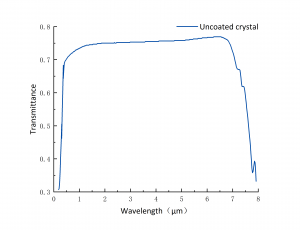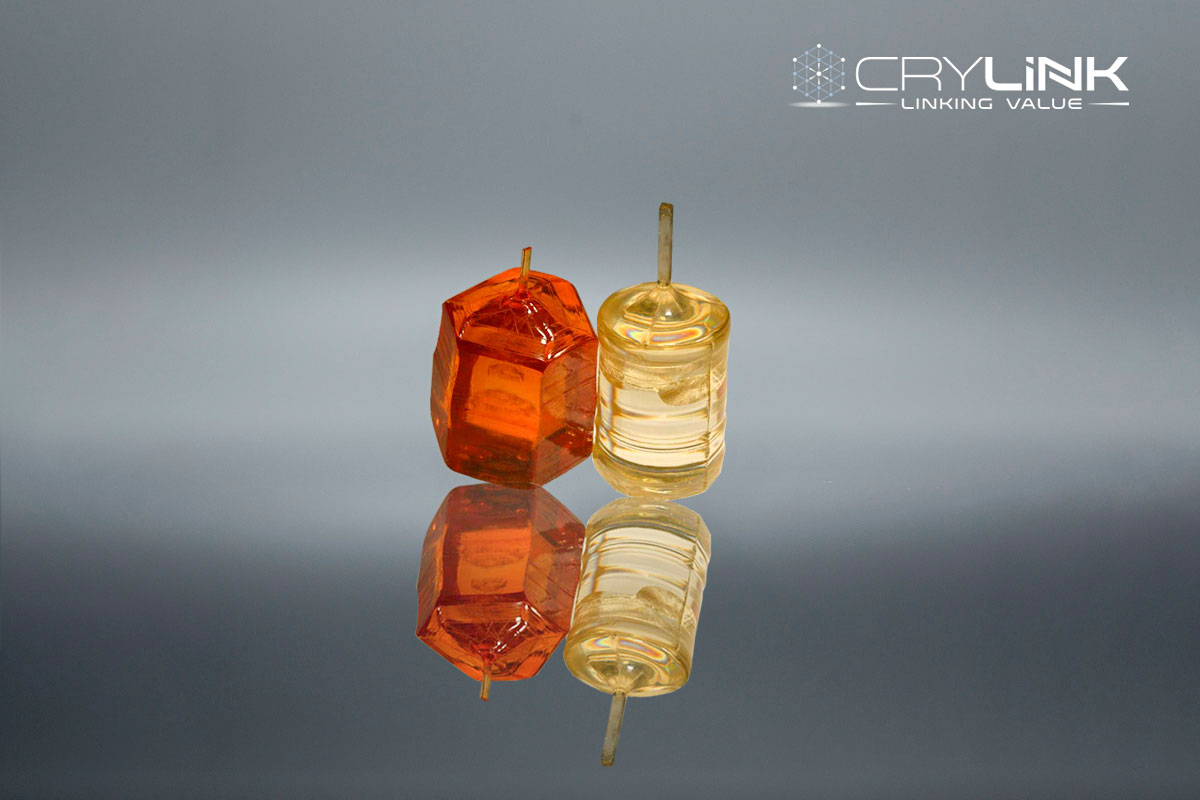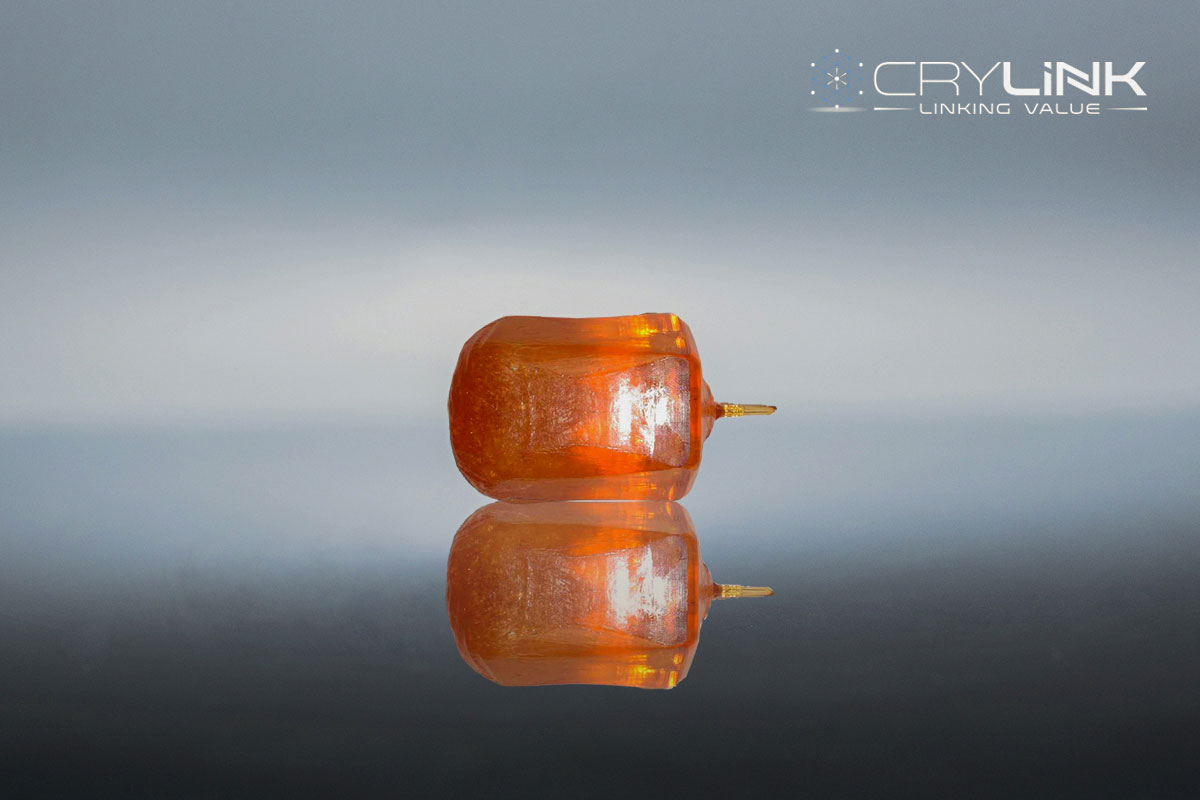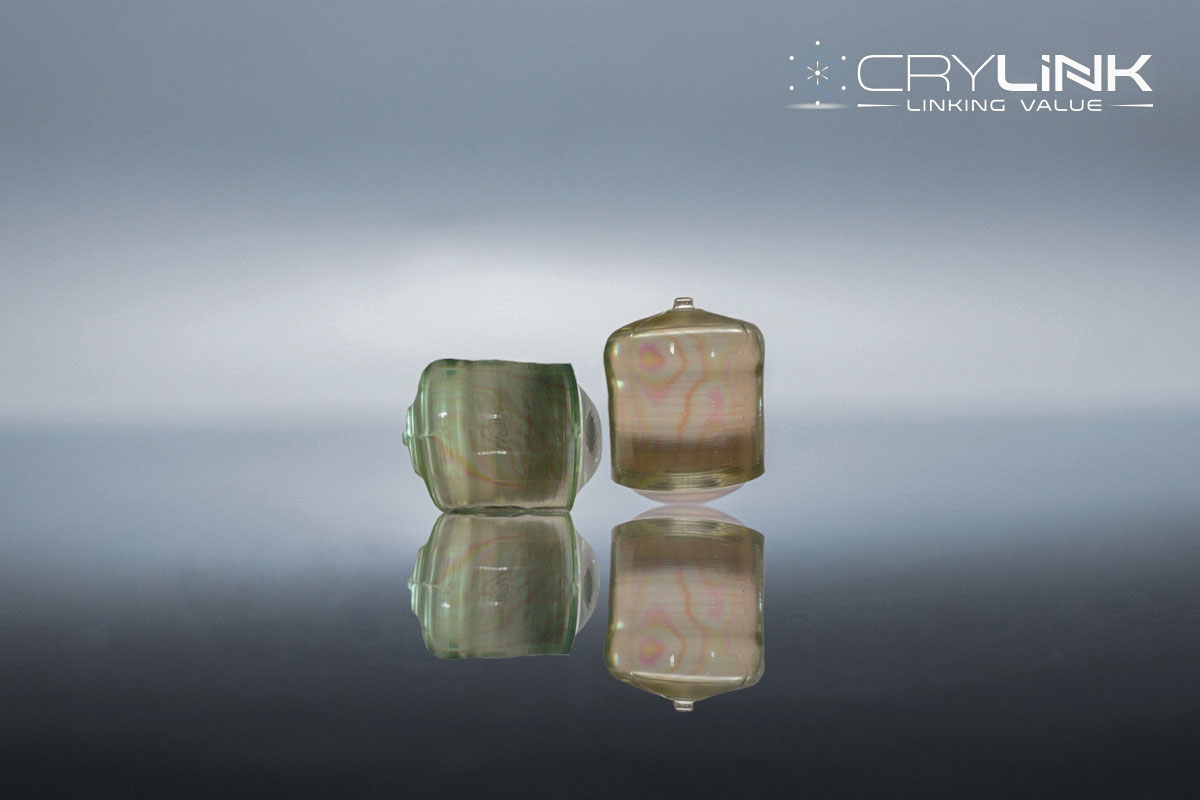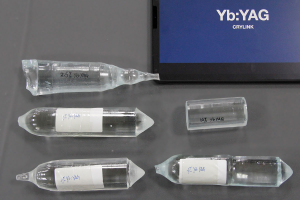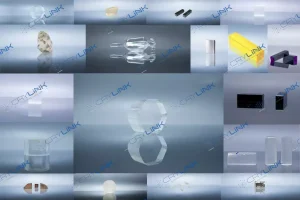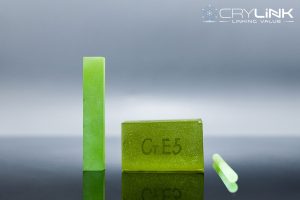TeO2
TeO2 Crystal For 370nm Acousto-Optic Modulation
Size: 15*14*10mm
Coating: Both Sides Coating; AR@370nm,T≥92%
TeO2 crystal case (2) for Acousto-optic modulation
Size: 10×10×4.53 mm;
Clear Aperture >90%
- Material Processing
355nm laser - Medical Applications
532nm laser
2100nm laser
2000nm laser - Acousto-optic coordinating filter
- Acousto-optic deflector
- Acousto-optic modulator
- Acousto-optic tunable filter
- Active Q-switch laser
Tellurium Dioxide (TeO2, Paratellurite) is an excellent acousto-optic crystal material, it is widely applied in the production of Acousto-optic modulator (AOM), Acousto-optical deflector (AOD), Acousto-optical tunable filter (AOTF), Laser Q-switches, RF spectrum analyzers in laser technology science and optoelectronic technology, because of its high figure of merit ,which depended on high elastic coefficient and high refractive index. TeO2 acousto-optic deflectors are more suitable for acousto-optic effects with high diffraction efficiency, long bandwidth and high beam deflection speed. TeO2 has been widely used to fabricate anomalous acousto-optic devices.
- Small sound attenuation
- Large sound and light quality factor
- High figure of merit
- Excellent sound and light characteristics
- High transparency to visible light
- High refractive index
| HIGH-STABILITY ACOUSTO-OPTICAL DEVICES USING BULK ACOUSTIC WAVES IN TeO2 0013-5194/78/170535-02$!. 50/0 |
| Measurement of Low Temperature Specific Heat of Crystalline TeO2 for the Optimization of Bolometric Detectors Journal of Low Temperature Physics, Vol. 123, Nos. 5/6, 2001 |
| Study on SAW Characteristics of AmorphousTeO2/128°Y-X LiNbO3 Structures 2007 IEEE Ultrasonics Symposium1894-1896 |
| Physical properties and structural studies of lithium borophosphate glasses containing TeO2 Journal of Solid State Chemistry 270 (2019) 547–552 |
If you can’t find the Literature you want, Contact us to get the PDF Get the Literature
| Growth of pure and doped TeO2 crystals for scintillating bolometers I. Dafinei et al. / Nuclear Instruments and Methods in Physics Research A 554 (2005) 195–200 |
| Growth of TeO2 single crystals by the low temperature gradient Czochralski method with nonuniform heating Journal of Crystal Growth 384 (2013) 1–4 |
| Investigations on the growth of Bi2TeO5 and TeO2 crystals Journal of Crystal Growth 197 (1999) 210—215 |
| Time-of-flight mass spectroscopy of femtosecond and nanosecond laser ablated TeO2 crystals S. Beke et al. / International Journal of Mass Spectrometry 299 (2011) 5–8 |
| Monte Carlo simulation of the Cherenkov radiation emitted by TeO2 crystal when crossed by cosmic muons Nuclear Instruments and Methods in Physics Research A 732 (2013) 338–341 |
| The superposition of one- and two-phonon absorption and radiation in TeO 2 crystal N.N. Syrbu, R.V. Cre(u / Infrared Physics & Technology 37 (1996) 769-775 |
| PtTe2: Potential new material for the growth of defect-free TeO2 single crystals Journal of Crystal Growth 310 (2008) 3077– 3083 |
| Paramagnetic and diamagnetic defects in e- and UV-irradiated TeO2 single crystal Nuclear Instruments and Methods in Physics Research B 191 (2002) 261–265 |
| Production of high purity TeO2 single crystals for the study of neutrinoless double beta decay Journal of Crystal Growth 312 (2010) 2999–3008 |
Parameter
| Property | Value |
| Chemical formula | TeO2 |
| Molar mass | 159.60 g/mol |
| Color | Colorless |
| Density | 5.99 ± 0.03 /cm3 |
| Melting Point | 733°C |
| Hardness | 3 – 4 Moh’s hardness scale |
| Thermal expansion | 10-6 К-1: α11 = 17.7; α22 = 17.7; α33 = 5.5 |
| Symmetry | Tetragonal, 422 (D4) |
| Lattice distances | a = 4.8122 Å; c = 7.6157 Å |
| Transmittivity | >70% at 633nm |
| Transmitting Range | 0.33 ~ 5.0 microns |
| λ, μm | no | ne | Δn = ne – no |
| 0.4047 | 2.4315 | 2.6167 | 0.1852 |
| 0.4358 | 2.3834 | 2.5583 | 0.1749 |
| 0.4678 | 2.3478 | 2.5164 | 0.1686 |
| 0.4800 | 2.3366 | 2.5036 | 0.1670 |
| 0.5086 | 2.3150 | 2.4779 | 0.1629 |
| 0.5461 | 2.2931 | 2.4520 | 0.1589 |
| 0.5893 | 2.2738 | 2.4295 | 0.1557 |
| 0.6328 | 2.2597 | 2.4119 | 0.1522 |
| 0.6438 | 2.2562 | 2.4086 | 0.1524 |
| 0.690 | 2.2450 | 2.3955 | 0.1505 |
| 0.800 | 2.226 | 2.373 | 0.147 |
| 1.00 | 2.208 | 2.352 | 0.144 |
| λ, μm | p, deg/mm | λ, μm | p, deg/mm |
| 0.3698 | 587.1 | 0.5893 | 104.9 |
| 0.3783 | 520.6 | 0.6328 | 86.9 |
| 0.3917 | 437.4 | 0.700 | 67.4 |
| 0.4152 | 337.6 | 0.800 | 48.5 |
| 0.4382 | 271.0 | 0.900 | 37.4 |
| 0.4630 | 221.1 | 1.00 | 29.5 |
| 0.4995 | 171.2 | 1.10 | 23.8 |
| 0.5300 | 143.4 |
| Nsound | Usound | Vsound 103 м/с | Nlight | Elight | M1 10-7сm2 · с/г | M2 10-18 с3/г |
| [100] | [100] | 2.98 | [010] | [100] | 0.097 | 0.048 |
| [100] | [100] | – | [010] | [001] | 22.9 | 10.6 |
| [001] | [001] | 4.26 | [010] | [100] | 142 | 34.5 |
| [001] | [001] | – | [010] | [001] | 113 | 25.6 |
| [100] | [010] | 3.04 | [001] | optional | 3.70 | 1.76 |
| [110] | [110] | 4.21 | [-110] | [110] | 323 | 0.802 |
| [110] | [110] | – | [-110] | [001] | 16.2 | 3.77 |
| [101] | [101] | 3.64 | [-101] | [010] | 101 | 33.4 |
| [010] | [010] | 2.98 | [-101] | [101] | 42.6 | 20.4 |
| [110] | [-110] | 0.617 | [001] | optional | 68.6 | 793 |
| [101] | [-101] | 2.08 | [010] | [100] | 76.4 | 77 |
| АОM main characteristics | Typical values for TeO2 modulators |
| Optical Wavelength Range | 514nm, 633nm, 1064nm, 1330nm |
| Optical Aperture | 0.3 mm – 3 mm |
| Operating Mode | Longitudinal, axis (001) |
| Optical Rise Time | 9-200 nsec on beam diametr |
| Beam Separation (633 nm) | 10-30 mrad |
| Diffraction Efficiency | 70-85 % |
| Modulation Frequency (-3db) | 6-50 MHz |
| АОD main characteristics | Typical values for TeO2 deflectors |
| Optical Wavelength Range | 540nm-530nm, 630nm-850nm, 700nm-1100nm, 1064nm, 1330nm |
| Optical Aperture | 1 mm – 10 mm |
| Operating Mode | Shear Wave, 3-15 degrees of axis (110) |
| Center frequency | 20- 200 MHz |
| Bandwidth | 20-100 MHz |
| Diffraction efficiency | 60-95% |
| Time aperture | 1-15 μs |
| Resolution (T.BW product) | 200-2000 |
| Optical Rise Time | 9-200 nsec on beam diameter |
| Deflection Angle | 10-100 mrad |
| ΔDeflection Angle | 5-50 mrad |
| RF input power | 0,1- 2 Wt |
| АОTF main characteristics | Typical values for TeO2 AOTFs |
| Tuning Range | 450-750nm, 900-1200nm, 1200-2500nm, 2500-5000nm |
| Bandwidth | 0.5 nm – 15 nm |
| Operating Mode | Slowshear, noncollinear propagation |
| Angular aperture | 2-10 degrees |
| Optical Aperture | 3×3 mm – 30×30 mm |
| Diffraction Efficiency | 70-85 % |
| RF power | 1-10 Wt |


